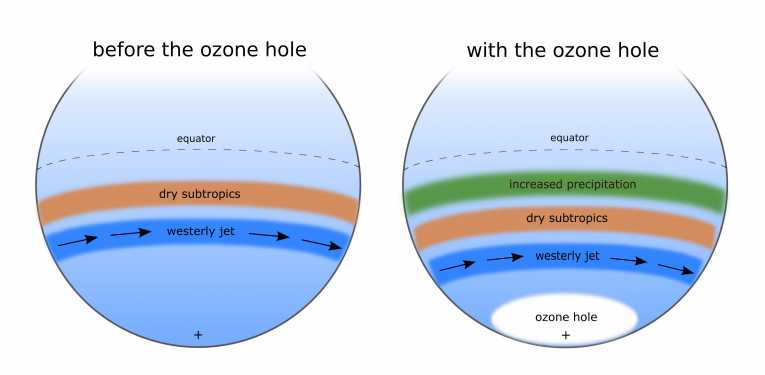Credit: (Image © Science/AAAS). (Image Caption: The impact of the ozone hole on Southern Hemisphere climate. The westerly jet and dry subtropics move towards the South Pole (cross) as the ozone hole forms and, as a result, subtropical precipitation increases.)
Carbon isn't the only game in town, it would seem. A new study, using state-of-the-art climate models, has tapped the ozone hole as being responsible for pushing out changes in climate as far afield as the tropics. The research - out today in Science magazine - was led by a pair of scientists from Columbia University, working together with colleagues at Canada's Centre for Climate Modelling and Analysis. It is the first to link the the ozone hole over Antarctica to changes in the climate system of the whole southern hemisphere; changes which are making the tropics much wetter.
The ozone holes over the north and south poles of the planet were first noticed in the 1980s, and the dangers of losing our shield from the sun's harmful UV radiation led to immediate action. The culprits, ozone-destroying chemicals, such as chlorofluorocarbons (CFCs), were quickly identified, and action taken to ban their use and control their emissions. But it seems the role of the ozone hole - especially that of the larger one in the southern hemisphere - in the climate system as a whole was underestimated.
That matters because even with CFCs banned under the Montreal Treaty - and the hole no longer growing - its ultimate healing could be several decades away. For some time now scientists have noticed that patterns of wind circulation around Antarctica appear to have changed as the ozone hole grew. But this new study shows that the effects of the ozone hole extend much further than just the icy wastes of the southernmost continent.
There has also been a noticeable change in the levels of rainfall in the southern hemisphere, over the last few decades, and the team - Lorenzo M. Polvani and Sarah Kang - wanted to know if the ozone hole was behind it. They tested this idea by taking two independent climate models, and introducing the observed ozone hole into them. They then looked to see how the models' rainfall patterns evolved - and they found that both models agreed with each other, and more importantly with the real world. That is a strong sign that it is the ozone hole that is driving these changes in sub-tropical precipitation.
The reason for this wide-ranging effect is down to the way the ozone hole affects the position of the bands of the main climate zones. These are closely corralled by the snaking bands of high-speed winds known as the jet-streams. There are pairs of these in each hemisphere, one polar, one sub-tropical. It appears that these jet-streams are moving southwards, in response to the ozone hole, dragging the dry subtropical zone behind it. That in turn is enhancing the rainfall levels in the southern subtropics.
This all has big implications for how we view climate change - it is no longer enough to see it as a simple story, focused only on greenhouse gas emissions. ''The ozone hole is not even mentioned in the summary for policymakers issued with the last IPCC report,'' said Polvani ''We show in this study that it has large and far-reaching impacts. The ozone hole is a big player in the climate system!''
''This could be a real game-changer,'' Polvani concluded.










